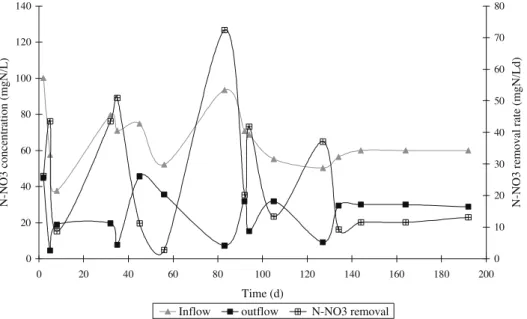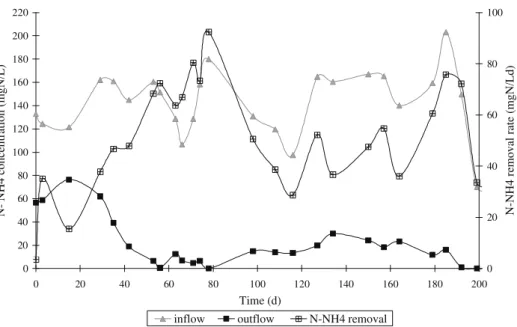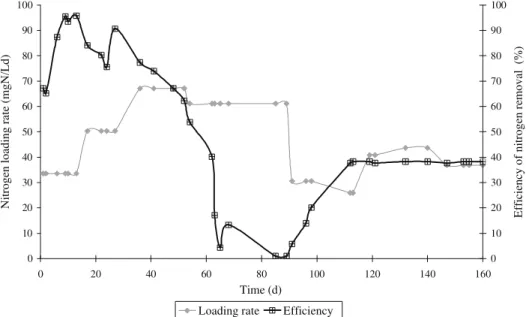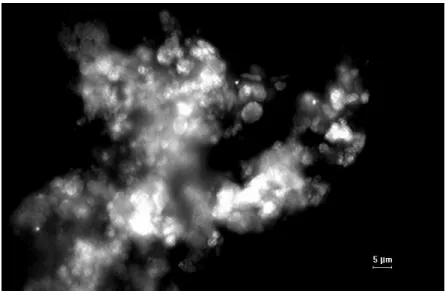ISSN 0104-6632 Printed in Brazil
www.abeq.org.br/bjche
Vol. 22, No. 04, pp. 593 - 600, October - December, 2005
Brazilian Journal
of Chemical
Engineering
ANAEROBIC AMMONIUM OXIDATION
IN A BIOREACTOR TREATING
SLAUGHTERHOUSE WASTEWATER
V. Reginatto
1*, R. M. Teixeira
1, F. Pereira
1, W. Schmidell
1, A. Furigo Jr
1, R. Menes
2,
C. Etchebehere
2and H. M. Soares
11
Chemical and Food Engineering Department, Technological Center, Federal University of Santa Catarina, Campus Universitário, Trindade, Phone: +55-48-331-9448, Fax: +55-48-331-9687,
P.O. Box 476, CEP 88040-900, Florianópolis - SC, Brazil. E-mail: reginatto@enq.ufsc.br
2
Cátedra de Microbiologia , Facultad de Química y Facultad de Ciencias, Universidad de la República. CC 1157, Montevideo, Uruguay.
E-mail: jmenes@fq.edu.uy, E-mail: cetchebe@fq.edu.uy
(Received: October 20, 2005 ; Accepted: July 11, 2005)
Abstract - Ammonium oxidation was thought to be an exclusively aerobic process; however, as recently described in the literature, it is also possible under anaerobic conditions and this process was named ANAMMOX. This work describes the operation of a system consisting of a denitrifying reactor coupled to a nitrifying reactor used for removal of nitrogen from slaughterhouse wastewater. During operation of the denitrifying reactor an average nitrogen ammonium removal rate of 50 mg/Ld was observed. This biomass was used to seed a second reactor, operated in repeated fed batch mode, fed with synthetic medium specific to the growth of bacteria responsible for the ANAMMOX process. The nitrogen loading rate varied between 33 and 67 mgN/Ldand average nitrogen removal was 95% and 40%, respectively. Results of fluorescence in situ
hybridization (FISH) confirmed the presence of anammox-like microorganisms in the enriched biomass.
Keywords: Nitrogen removal; Anaerobic ammonium oxidation; ANAMMOX; Slaughterhouse wastewater.
INTRODUCTION
The nitrogen in industrial wastewater is mainly found in organic forms like protein or urea, which form ammonium following hydrolysis (Mudrack and Kunst, 1994). Ammonium nitrogen discharged into the environment is extremely harmful due to the high toxicity of free ammonia at a pH higher than 8.0 and also because of its oxygen demand in bodies of water (EPA, 1975).
Until few years ago the only known way to remove nitrogen from wastewater by biological processes was with a system of nitrification and denitrification. In nitrification, first ammonium is oxidized to nitrite by the nitritation process and then to nitrate, mainly by autotrophic bacteria of the
genera Nitrosomonas and Nitrobacter. In denitrification, heterotrophic bacteria reduce nitrate in the absence of oxygen, using organic matter as electron donor, producing intermediates like NO2,
NO, N2O and finally N2 gas, which is removed from
the liquid phase (Etchebehere et al., 2001).
In 1995 in Holland, Mulder and co-workers observed for the first time ammonium oxidation under anaerobic conditions and named this process Anaerobic Ammonium Oxidation or ANAMMOX. Years prior to the discovery of this process, based on thermodynamic studies, Broda (1977) foresaw the possibility of microorganisms able to oxidize ammonium using nitrate or nitrite as electron
acceptor. According to the ANAMMOX
shown in Equation 1, the theoretical rate of substrate consumption (NO2
-/NH4 +
) is 1.32, while the rate of nitrate formation and ammonium consumption (NO3
-/NH4+) is 0.26.
+
4 2 3
+
2 3
2 0.5 0.15 2
NH + 1.32NO - + 0.066HCO - +
+0.13H 1.02N + 0.26NO - +
+0.066 CH O N + 2.03 H O
→ (1)
Microorganisms responsible for anaerobic ammonium oxidation were identified as belonging to the phylum Planctomycetes and are as Candidatus
Brocadia anammoxidans (Strous et al., 1999), Candidatus Kuenenia stutgartiensis, Candidatus
Scalindua wagneri and Candidatus Scalindua brodae
(Kuypers et al., 2003). The first two have been found in wastewater treatment systems. Scalindua has also been detected in many marine ecosystems.
In the last several years, there have been an increasing number of articles in the specialized literature showing the advantages of the ANAMMOX process over the traditional one, such as less need for aeration for nitrification and occasionally the addition of organic matter for denitrification. In addition, costs related to sludge disposal are reduced because of the lower rate of growth of the microorganisms responsible for ANAMMOX than of the ones responsible for the nitrification/denitrification process (Ye and Thomas, 2001).
In Brazil this new process in anaerobic reactors has not yet been described. Thus, this work describes the capacity of a biomass from a nitrification-denitrification reactor system used to treat
slaughterhouse wastewater to remove nitrogen by the ANAMMOX process.
MATERIAL AND METHODS
Nitrification-Denitrification System Set-up
The system was composed of two reactors with continuous flow operated in series: a hybrid anaerobic reactor connected to an upflow biological filter with submerged aeration with recycling for the hybrid reactor. The two reactors were constructed of glass with a diameter of 6cm and a height of 40 cm and were filled with corrugated pipes of PVC with a ½ inch diameter. The aerobic and anaerobic reactors have 790 mL and 745 mL of effective volume, respectively. The reactors had been connected according to Figure 1.
System Operation
Inoculum used for the hybrid reactor was from an anaerobic stabilization pond at a chicken and swine processing plant and that for the aerobic reactor was from a domestic wastewater treatment plant. Nitrifying and denitrifying biomasses were enriched by feeding with synthetic medium during reactor start-up, as described elsewhere (Teixeira et al., 2000). After the start-up period, the reactor system was fed with wastewater from a slaughterhouse pretreated in an anaerobic stabilization pond, whose composition is shown in Table 1. A peristaltic pump containing two headstocks provided an outflow of 475 mL/d with a recycle ratio (R) of 1.8.
Table 1: Chemical characterization of slaughterhouse wastewater
C
Coommppoonneenntt
N-NH4+ (mg/L) 163.7 (±31.6)
N-NO3- (mg/L) nd
N-NO2- (mg/L) nd
COD (mgO2/L) 614.5 (± 130.4)
pH 7.20 (± 0.32)
nd: not detected
Mass Balance for the Denitrifying Reactor
The efficiency of the denitrifying reactor in removing chemical oxygen demand (COD) and nitrogen as ammonium (N-NH4
+
) and nitrate (N-NO3
-) depends on the recycle ratio. Equation 2 represents COD and nitrogen mass balance for the denitrifying reactor for the steady state period, for the reactor configuration shown in Figure 1.
e m d
r V = Q[C] + RQ[C] - (Q + RQ)[C] (2)
r: removal rate of N-NH4 +
, N-NOx
or COD in the denitrification reactor (mgL/d);
V: reactor volume (L); Q: flow rate (L/d); [C]e: N-NH4
+
, N-NOx
or COD concentration in influent (mg/L);
[C]m: N-NH4 +
, N-NOx
recycle (mg/L);
[C]d: N-NH4+, N-NOx- or COD concentration in the
effluent (mg/L); R: recycle ratio (=1.8)
Enrichment of Denitrifying Sludge in Microorganisms Responsible for Anaerobic Ammonium Oxidation
After 200 days of operation of the nitrification-denitrification reactor system, sludge from the denitrifying reactor was taken and used to seed an anaerobic Repeated Fed Batch (also called a sequencing batch reactor – SBR) reactor with a 250 mL volume, which was operated for 160 days with total cell retention. The denitrifying sludge was fed with an autotrophic synthetic medium containing ammonium, nitrite, bicarbonate and micronutrients proposed by van de Graaf et al. (1996). The reactor was fed daily using a syringe to remove a specific volume from the reactor and feed in the same volume of fresh synthetic medium. The volume fed in varied from 40 to 80ml per day during the period of operation, varying nitrogen loading from 33 to 67 mgN/Ld. The anaerobic conditions were assured by flushing with helium for 20 minutes and sealing the reactor with butyl rubber stoppers. The pH was kept between 7.5 and 8.0 using NaOH or HCl 01N, and the temperature was maintained at 35 oC ± 0.5oC.
Analytical Methods
Ammonium nitrogen (N-NH4 +
) was analyzed by the colorimetric method of Nessler according to Vogel (1981). Nitrite was determined colorimetrically with the Nitriver kit (HACH® Company) and nitrate was determined by the method of acetyl salicylic acid (Cataldo et al., 1975). The chemical oxygen demand (COD) was determined by the method of closed reflux according to Standard Methods for Examination of Water and Wastewater (APHA, AWWA, WEF, 1995). The N2 was measured by gas
chromatography (Perkin-Elmer 1B) with a thermal conductivity detector and a Porapak Q® column.
Fluorescence in Situ Hybridization (FISH) and Microscopy
Samples taken at the end of the period of operation were fixed by adding three volumes of 4% (w/v) paraformaldehyde in PBS (130 mM NaCl, 10
mM sodium phosphate) for 3 h at 4°C. Then the cells were washed twice with PBS, resuspended in PBS:ethanol (1:1) and stored at –20°C. For enumeration, the biomass was resuspended in sodium pyrophospate (2.8gL-1) and homogenized for 1 min with an ultrasonic probe. Five µl of fixed samples were spotted onto microscopic slides and sequentially dehydrated and hybridized with a Cy3-labeled probe (Amx820) in accordance with Egli et al. (2003). Slides were incubated in the washing
buffer with 0.1 mgL-1 of
4,6-diamidino-2-phenylindole (DAPI) for 10 min at 48°C, dried and observed with an Olympus BX41 microscope equipped with MWU (DAPI) and MWIG (Cy3) filters. Digital images were captured with a CCD camera and acquired with the program Image-ProPlus (MediaCybernetics Inc., MD, USA).
RESULTS AND DISCUSSIONS
Denitrifying Reactor
This work addresses nitrogen loss in the denitrifying reactor (anaerobic), and the mass balances of the wastewater components are shown only for the denitrifying reactor, keeping in mind that it was coupled to the aerobic one, as shown in Figure 1.
In Figures 2 and 3 the inflow and outflow of COD and nitrate concentrations and their removal, are represented. The denitrifying reactor should be able to reduce nitrate coming from the aerobic reactor to nitrogen gas using wastewater COD as electron donor; however this was not the only nitrogen elimination metabolic pathway. In Figure 2 it can be observed that COD removal in the denitrifying reactor oscillated with COD concentration in the influent. After 100 days COD removal remained about 170mgCOD/Ld. Denitrification stoichometry proposes that about 3.7mg COD are necessary to reduce 1.0mg N-NO3
-(Henze et al., 1997); thus the amount of COD consumed should be able to denitrify around 46mgN/Ld of N-NO3-. However, as can be verified
Figure 1: Scheme of experimental reactors
0 100 200 300 400 500 600 700 800
0 20 40 60 80 100 120 140 160 180 200
Time (d)
COD concentration (mg/L)
0 100 200 300 400 500
COD removal rate (mg/Ld)
Inflow Outflow COD removal
Figure 2: COD concentration in the influent and effluent and removal rate in the denitrifying reactor.
0 20 40 60 80 100 120 140
0 20 40 60 80 100 120 140 160 180 200
Time (d)
N-NO3 concentration (mgN/L)
0 10 20 30 40 50 60 70 80
N-NO3 removal rate (mgN/Ld)
Inflow outflow N-NO3 removal
Results described above suggest the difficulty to establish conventional heterotrophic denitrification, which could be attributed to different factors, as discussed below.
The COD consumption observed in the
denitrifying reactor (Fig. 2) could take place by anaerobic digestion, which could possibly occur together with anaerobic heterotrophic denitrification.
Inhibition of one of the denitrification steps, generating an intermediate should also be taken into account. The possible inhibition of denitrification by a wastewater compound was not examined in depth in this work, but if this process were inhibited, intermediates like N-NO2- could be produced in the
reactor and quickly reduced by an alternative electron donor, for example ammonium ion in the case of the ANAMMOX process.
Another possibility is that the influent could bring into the denitrifying reactor dissolved oxygen from nitrification or from the feeding that would be used to cause nitritation, i.e., to oxidize part of the N-NH4+ to
N-NO2
-, therebyallowing the ANAMMOX process to become established. In addition, if the ANAMMOX process occurs, for one of the reasons discussed above, according to the ANAMMOX stoichometry described in Equation 1, nitrate will be produced, contributing to a lower rate of nitrate removal.
In Figure 4 the concentration of ammonium nitrogen in the reactor influent and effluent and the ammonium nitrogen conversion (removal) in the
denitrifying reactor are shown, taking into account the recycle coming from the aerobic reactor, in accordance with the mass balance given in Equation 2.
In Figure 4 it is shown that the ammonium nitrogen concentration in the denitrifying reactor was lower than that in the influent (see Table 1), probably due to the dilution effect of the recycle rate in the nitrification reactor. However, in accordance with the mass balance for this reactor (Equation 2), a mean ammonium nitrogen removal rate of around 50mgN/Ld was verified for the entire period monitored. This conversion was higher in the interval of 50to 80 days reaching a maximum value of 92.4mgN/Ld. During the 150th and 200th days of operation another period of high nitrogen ammonium conversion of about 57 mgN/Ld was observed. The nitrogen incorporation of the cells to form biomass is not enough to explain this result. One of the possibilities is that the biomass may be able to cause ANAMMOX using NO2- that was probably produced
by inhibition of denitrification or by nitritation, as discussed above. It was recently suggested by some authors that the ANAMMOX process is the cause of ammonium nitrogen losses in denitrifying reactors (Mulder et al., 1995; Jetten et al., 1999). Based on this hypothesis, part of the biomass was transferred from the denitrifying reactor to a second reactor, which was operated under optimal conditions to study the process of anaerobic ammonium oxidation.
0 20 40 60 80 100 120 140 160 180 200 220
0 20 40 60 80 100 120 140 160 180 200
Time (d)
N- NH4 concentration (mgN/L)
0 20 40 60 80 100
N-NH4 removal rate (mgN/Ld)
inflow outflow N-NH4 removal
ANAMMOX Enrichment Reactor
During the enrichment of microorganisms able to cause the ANAMMOX process, an autotrophic synthetic medium as described in Materials and Methods was used. The nitrogen loading rate used in the reactor, calculated as the total amount of N-NH4
+
and N-NO2- concentrations, varied from 33 to 67
mgN/Ld, as shown in Figure 5.
During the first 19 days the nitrogen loading rate used in the reactor was 33mgN/Ld, reaching 95% nitrogen removal. Considering that the residual ammonium concentration in the reactor was low, the load was increased to 50mgN/Ld until day 40, when the load was increased to 67mgN/Ld.
In this last step, the feeding that was initially done once was changed to twice a day. This procedure aimed to reduce the overload of nitrite and ammonium during the feeding. This load was maintained for 22 days but during this time a decrease in the efficiency of nitrogen elimination was observed as can be clearly observed in Figure 5. A nitrogen loading rate of about 60mgN/Ld was maintained from day 54 to 89 in an attempt to achieve the adaptation of the microorganisms to this nitrogen load. However, the adaptation was not observed and the nitrogen loading rate had to be decreased to values lower than those used at the beginning of the operation (33mgN/Ld).
0 10 20 30 40 50 60 70 80 90 100
0 20 40 60 80 100 120 140 160
Time (d)
Nitrogen loading rate (mgN/Ld)
0 10 20 30 40 50 60 70 80 90 100
Efficiency of nitrogen removal (%)
Loading rate Efficiency
Figure 5: Nitrogen loading rate and the efficiency of nitrogen removal under anaerobic conditions.
After this alteration, the efficiency of nitrogen elimination returned to about 40 %, showing that inhibition by a higher nitrogen load was reversible. The reactor was submitted to another increase in loading rate to 40mgN/Ld and the efficiency of nitrogen elimination remained around 40 % during a period of 50 days. Gas-chromatography analysis in this phase revealed 98 % N2 in the gas content. The
concomitant consumption of nitrite and ammonium under anoxic conditions with N2 formation suggested
that the nitrogen elimination observed occurred by this new recently described metabolic pathway – ANAMMOX (Jetten et al., 1999).
To confirm this hypothesis a fluorescence in situ
hybridization analysis was carried out with a specific
probe for the group of anammox-like bacteria (Amx 820) described in the literature (Egli et al., 2003). Hybridization of the enriched biomass with the specific probe can be observed in Figure 6. The light area represents hybridization of the biomass sample with the Amx 820 fluorescently labeled probe; stained cells in dense aggregates of coccoid morphology can be seen. The cells showed an inner area with a lower signal intensity, as had been described previously for the anammox-like microorganisms (Egli et al., 2003).
Figure 6: Epifluoresce micrograph of anaerobic ammonium-oxidizing enrichment reactor biomass after in situ hybridization with Amx820 Cy3-labeled probe.
CONCLUSIONS
In this work the difficulty to establish a conventional heterotrophic denitrification process to treat slaughterhouse wastewater was verified. More detailed studies to address a possible inhibition of denitrification by the effluent are being carried out in our laboratory. On the other hand, an unusual loss of ammonium nitrogen was observed in the denitrifying reactor. During the sludge enrichment period, providing optimal conditions for the ANAMMOX process, the consumption of nitrite and ammonium with the formation of N2 was verified. Studies with
fluorescence in situ hybridization concluded that
microorganisms belonging to the phylum
Planctomycetes were present in the enriched sludge. These results confirmed that nitrogen loss in the denitrifying reactor was by ANAMMOX. This process promises to be a sustainable treatment for nitrogen removal of the slaughterhouse effluent studied.
ACKNOWLEDGMENTS
The authors are grateful to CNPq and Sadia S.A. for their financial support of this research.
REFERENCES
Akunna, J., Bizeau, C., Moletta, R., Bernet, N. and Heduit, A., Combined Organic Carbon and Complete Nitrogen Removal Using Anaerobic
and Aerobic Upflow Filters, Wat. Sci. Tech., vol. 30, n° 12, pp. 297-306 (1994).
APHA – American Public Health Association, Standard Methods for the Examination of Water and Wastewater, 19th ed, Washington, D.C. (1995).
Broda, E., Two Kinds of Lithotrophs Missing in Nature, Zeitschrift für Allg. Mikrobiologie, vol. 17, pp. 491-493 (1977).
Cataldo, D.A., Haroon, M., Schrader, L.E. and Youngs, V.L., Rapid Colorimetric Determination of Nitrate in Plant Tissue by Nitration of Salicylic Acid, Comun. Soil Sci. Plant Anal., vol. 6, pp. 71-80 (1975).
Egli, K., Bosshard, C., Werlen, C., Lais, P., Siegrist, H., Zehnder, A.J.B. and van der Meer, J.R., Microbial Composition and Structure of a Rotating Biological Contactor Biofilm Treating Ammonium-rich Wastewater without Organic Carbon, Microb. Ecol., vol. 45, pp. 419-432 (2003).
Environmental Protection Agency, EPA Process Design Manual for Nitrogen Control U.S. - Technology Transfer.Washington, D.C. Chapter 3, pp. 2-3 (1975).
Etchebehere, C., Errazquin, I., Barrandeguy, E., Dabert, P., Moletta, R. and Muxi, L. Evaluation of the Denitrifying Microbiota of Anoxic Reactors, FEMS Microbiology Ecology, vol. 35, pp. 259-265 (2001).
HACH, Spectrophotometer Handbook DR/2010. Procedure Manual, Hach Company, 2000. Henze, M., Harremoes, P., Jansen, J.C. and Arvin,
Chemical Processes. Springer Verlag, 2thed, Germany (1997).
Jetten, M.S.M., Strous, M., Pas-Schoonen, K.T., Schalk, J., van Dongen, U.G., van de Graff, A.A., Logemann, S., Muyzer, G., Loosdrecht, M.C and Kuenen, J.G., The Anaerobic Oxidation of Ammonium, FEMS Microbiol. Reviews, vol. 22, pp. 421-437 (1999).
Kuypers, M.A., Sliekers, O., Lavik, G., Schmid, M., Jørgensen, B.B., Kuenen, J.G., Damsté, J.S.S., Strous, M. and Jetten, M.S.M., Anaerobic Ammonium Oxidation by Anammox Bacteria in the Black Sea, Nature, n° 422, pp. 608-611 (2003).
Mudrack, K. and Kunst, S., Biologie der Abwasser-Reinigung. 4.Auf. Gustav Fischer Verlag– Stuttgart, p. 204 (1994).
Mulder, A., van de Graaf, A.A., Robertson, L.A. and Kuenen, J.G., Anaerobic Ammonium Oxidation Discovered in a Denitrifying Fluidized Bed Reactor, FEMS Microbiol. Ecology, vol. 16, pp. 177-184 (1995).
Sliekers, A.O., Derwort, N., Campos Gomez, J.G., Strous, M., Kuenen, J.G. and Jetten, M.S.M., Completely Autotrophic Nitrogen Removal over Nitrite in One Single Reator, Water Research,
vol. 36, pp. 2475-2482 (2002).
Strous, M., Kuenen, J.G. and Jetten, M.S.M., Key Physiology of Anaerobic Ammonium Oxidation, Applied and Environmental Microbiology, vol. 50, pp. 589-596 (1999).
Teixeira, R.M., Pereira, E.B., Pereira, F.F., Soares, H.M., Reginatto, V. and Furigo Jr., A., Remoção de Nitrogênio de Efluente Industrial Utilizando Biorreatores, Anais do XIV Congresso Brasileiro de Engenharia Química, ABEQ. Natal (2002). Van de Graaf, A.A., Bruijn, P., Robertson, L.A.,
Jetten, M.S.M. and Kuenen, J.G., Autotrophic Growth of Anaerobic Ammonium-oxidizing Micro-organisms in a Fluidized Bed Reactor, Microbiology, vol. 142, pp. 2187-2196 (1996). Van Dongen, L.G.J.M., Jetten, M.S.M. and van
Loosdrecht, M.C.M., The Combined Sharon/Anammox Process. Stowa: Foundation for Applied Water Research. IWA Publishing, London (2001).
Vogel, A.I., Análise Inorgânica Quantitativa. 4thed, Rio de Janeiro, Guanabara (1981).



